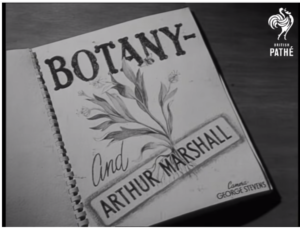
When intelligence officer Arthur Marshall was on the beach at Dunkirk in 1940 he turned to the work of Angela Brazil for psychological support. Wounded in the ankle, he encouraged his men to face enemy fire and so reach the awaiting ships with: “Come on, girls, who’s on for the Botany Walk?”
In his autobiography he explained how he managed to get through the evacuation:
Because of my admiration for Angela Brazil, I chose to imagine that we were all in a vast girls’ school: Headmistress, Miss Gladys Gort; School colours, khaki and black; School motto, Don’t Look Back Or You Might See Something Nasty. All the junior girls were dead nuts on that new and dashing hockey mistress, Miss Brenda Montgomery” .
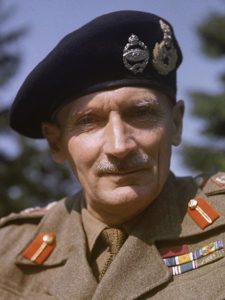
“Gladys” Gort was of course Field Marshal John Standish Surtees Prendergast Vereker, 6th Viscount Gort, VC, GCB, CBE, DSO& Two Bars, MVO, MC commander of the British Expeditionary Force sent to France in 1939.
And Brenda the “dashing hockey mistress” was Field Marshal Bernard Law Montgomery, 1st Viscount Montgomery of Alamein, KG, GCB,DSO, PC, DL
As leader of a Field Security Section, Marshall had several meetings with Miss Montgomery.
He was kind enough to appear interested in our activities and while he asked me various questions I became fascinated, inconsequentially, by the elegance and length of his nose. Could all of it possibly be real? Dare one give it an investigative tweak? Better not, perhaps.
With the German army closing in Marshall set off on a mission with his driver. Both were unarmed. What if you meet some Germans he was asked, “I shall give them a very dirty look’, he replied.
Reflecting on Dunkirk in his autobiography he wrote:
Absence of food, coupled with exhaustion, made the nights seem unusually cold and there is little of comfort, save protection of a sort, to be found in a sand dune. One’s childhood love of sand and beaches disappeared in a trice.
Camp or not, Marshall ended the war with an MBE and the rank of Lieutenant Colonel. Entertaining his companions he called himself Second Lieutenant Marigold Marshall, and addressed them in the manner of a school story headmistress. He told his fellow officers that the initial ‘C’ in his own name stood for Cynthia. ‘Damn silly name for a man,’ said a gloomy major, but called Marshall Cynthia every evening in the mess.
Marshall had been ardent reader of Brazil’s school stories as well as an early parodist. He made a name for himself before and after the war performing skits based on the school stories starring himself as headmistress. He was also a teacher and then housemaster at Oundle – a school he had attended before Cambridge where he had studied modern languages. He went on to become a well known raconteur and BBC radio regular.
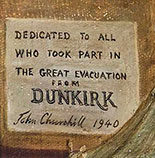 There’s a great story behind this magnificent eyewitness painting of Dunkirk by John Spencer-Churchill. He made sketches while he was on the beach that he turned into this painting. He gave it to his uncle – Winston Churchill – after the war.
There’s a great story behind this magnificent eyewitness painting of Dunkirk by John Spencer-Churchill. He made sketches while he was on the beach that he turned into this painting. He gave it to his uncle – Winston Churchill – after the war.
As a wall sign on the left of the painting he dedicates it “To all who took part in the great evacuation from Dunkirk.
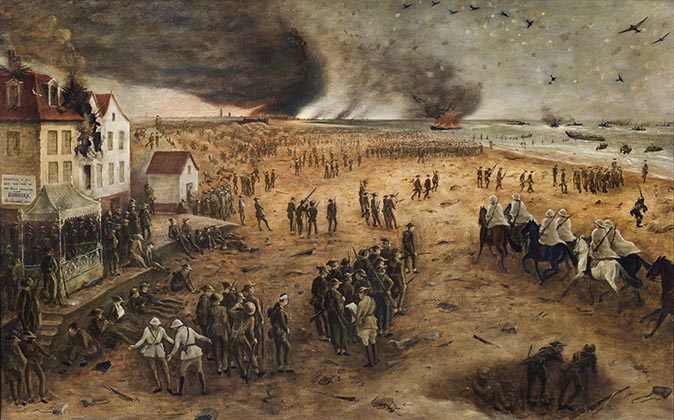
In the middle distance, the paddleship-turned-minesweeper Crested Eagle burns. Her bones still show today at low tide. French North African spahi cavalry trot along the shore
You can read the story behind the painting here
In Focus: The painting by Churchill’s nephew that gives a unique view of the evacuation of Dunkirk
Arthur Marshall was not the only one to parody the girls’ school story genre. Lord Berners writing in 1937 did so under the name Adela Quebec and scandalized his friends with a scurrilous spoof. Phillip Larkin had a go and of course the cartoonist Ronald Searles – who had developed some of his ideas as a Japanese prisoner of war – gave us a version with St Trinian’s.
St. Trinian’s School for Girls was comically cruel and brutal – a war zone where girls were thugs; the teachers odious and the headmistresses monsters.
Girls have to be frisked for weapons as they return to school.
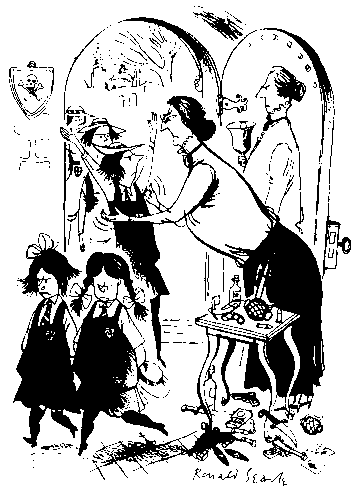
“Bang goes another pair of knuckledusters.”
Teachers callously step over dead bodies in the hallways.
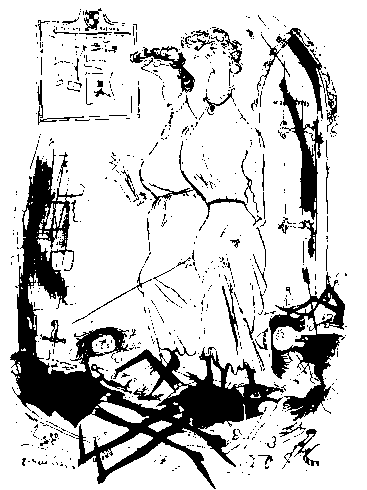
“Cleaners getting slack, Horsefall.”
Arson is one of their hobbies.
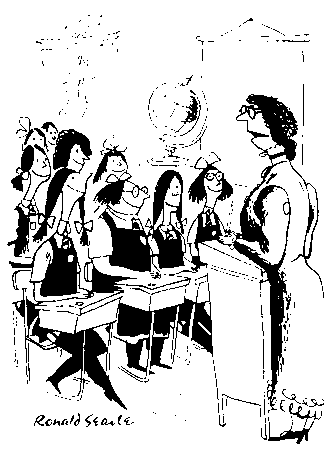
“Hand up the girl who burnt down the East Wing last night.”
They drink and smoke.

“Hell! My best Scotch.”
Teachers are for murdering.
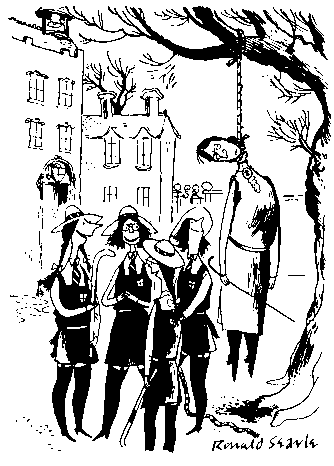
“Well, that’s O.K. – now for old ‘Stinks’ “
And hockey is a deadly game.
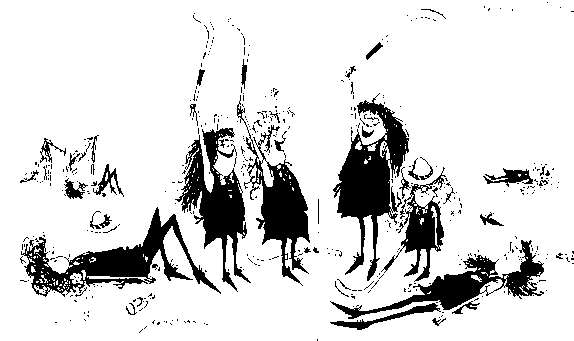
The work of and world of Angela Brazil deserves better than all this gender-bendering and sometimes hyper-sexualized mockery – good natured though some of it is.
Brazil was easy to parody. Years ago I even had a go myself with “Beryl Goes to School”. But Angela Brazil actually deserves better and so do her girls, her schools and her heads of school. Brazil’s schools were places of activity, friendship, honor and loyalty. Her girls were good-natured, high spirited and always up for adventure. And they were happy.
So that will be the focus of my next post.
But before we leave the world of parody, here’s Arthur “Marigold” Marshall – school teacher and BBC performer from a 1946 Pathé film.
And here’s something to whet the appetite:
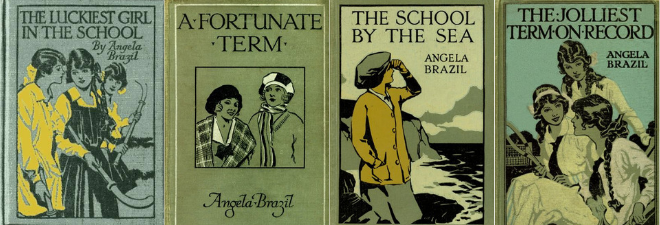
References:
- Bailey, Paul (2001). Three Queer Lives: an Alternative Biography of Fred Barnes, Naomi Jacob and Arthur Marshall. London: Hamish Hamilton.
- Marshall, Arthur (1984). Life’s Rich Pageant. London: Hamish Hamilton.
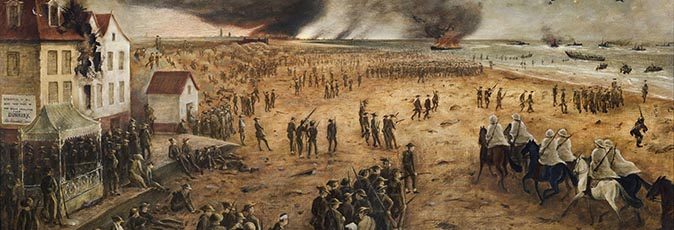


Thank you for this, I had no idea that the Arthur Marshall I used to watch on Call my Bluff had this history.
I recognise some of those story covers, too, from hand-me-down books I had as a child.
I didn’t either until I started reading Angela Brazil and then reading up about her. And I did not expect Brazil’s books to be so interesting and engrossing. In their own way they stand up to a test of time in spite of being so creaky and full of dreadful stereotypes.
I’m not a girl but I do look forward to your posts!
I’m looking for a book and you might be able to help! A new poetry book arrived in my primary school class in the mid to late 1950’s. It featured Ted Hughes, Charles Causley, Phillip Larkin and others including a some female poets. It is only recently that I’ve twigged that it could be THAT book of poems that started me writing!
Would love to help you track down that book. What else can you remember about it? Cover? Any specific poems?
Can’t get to a book to react at present but something to look forward to. Love the stylised jacket covers….and the overall approach is very St Trinians…rebellion at its best…if only!
Brazil girls were very loyal to their schools and would never think of smoking cigars during assembly nor watering the gin. They were plucky and got into some awful scrapes none of which involved arson or murder. the very idea! Take an Order Mark.